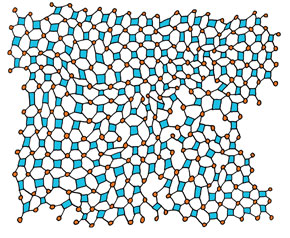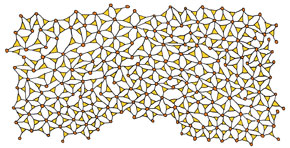 LUANA GEIGERThe first database of natural chemical compounds extracted from Brazil’s biodiversity has started to attract attention from researchers all over the world. The NuBBE Database offers information on 640 substances, ranging from the principal physical-chemical and biological properties to their three-dimensional structure, data essential for medicinal chemistry researchers and companies. The collection, available online at compiles 15 years of knowledge obtained from the research conducted at the Center for Natural Products Bioassays, Biosynthesis and Eco-physiology (NuBBE) at the Universidade Estadual Paulista (Unesp), in the city of Araraquara. “The level of detail of the information sets our natural products database apart from others around the world,” says Vanderlan Bolzani, professor at Unesp’s Institute of Chemistry (IQ) in Araraquara and NuBBE coordinator, referring to major databases such as Napralert, with over 200,000 compounds, or NPact, which covers roughly 1,500 natural compounds having anticancer properties.
LUANA GEIGERThe first database of natural chemical compounds extracted from Brazil’s biodiversity has started to attract attention from researchers all over the world. The NuBBE Database offers information on 640 substances, ranging from the principal physical-chemical and biological properties to their three-dimensional structure, data essential for medicinal chemistry researchers and companies. The collection, available online at compiles 15 years of knowledge obtained from the research conducted at the Center for Natural Products Bioassays, Biosynthesis and Eco-physiology (NuBBE) at the Universidade Estadual Paulista (Unesp), in the city of Araraquara. “The level of detail of the information sets our natural products database apart from others around the world,” says Vanderlan Bolzani, professor at Unesp’s Institute of Chemistry (IQ) in Araraquara and NuBBE coordinator, referring to major databases such as Napralert, with over 200,000 compounds, or NPact, which covers roughly 1,500 natural compounds having anticancer properties.
“Natural product databases provide information about species distribution, habitats, some physical-chemical properties, and the structure of compounds, but they don’t always provide other molecular markers that correlate molecular structure with biologic activity and that are essential for medicinal chemistry research. In addition to the usual physical-chemical properties of each molecule, NuBBE includes important data like solubility, hydrogen bonds, molecular volume, theoretical partition coefficient, and violation of Lipinski’s rule, among others, all of which are vital for a natural substance to reach prototype stage,” she says. This group of properties helps define the compound’s future at more advanced stages of new drug planning. The database also identifies the species from which a substance was isolated, and where it can be found. “The data are also important for academic research on biodiversity. If I can correlate a phytogeographic distribution in a particular region of the Atlantic Forest or Cerrado with the classes of substances produced by a certain group of species, we will have very valuable information for the advancement of knowledge, such as for chemotaxonomy, ecophysiology, chemical ecology, or public policies such as the preservation of species that are rich in added-value chemical constituents,” says Bolzani.
Eighty percent of all compounds in the NuBBE database were isolated from plants, 6% from fungi or microorganisms, 7% from synthetic compounds inspired by natural products, 5% from semi-synthetic compounds, and 2% from the products of biotransformation (modified by enzymes). The database was first announced in 2013 in an article in the Journal of Natural Products, a leading journal in the field, co-published by the American Chemical Society. The article was mentioned on the National Institutes of Health (NIH) website as one of 2013’s most significant publications on natural products. In November, the database was featured in respected trade magazine Drug Discovery Today, in an article about chemical product databases. In another sign of recognition, the Zinc database—the world’s largest on medicinal chemistry with entries for more than 35 million compounds—hosted at the Department of Pharmaceutical Chemistry of the University of California San Francisco, is now cross-linked with the NuBBE database. “We were recently contacted by the British Royal Society of Chemistry, host of the world-famous chemical database Chem-Spider, which covers 30 million structures from hundreds of different sources,” says Bolzani. “The RSC is interested in natural products from tropical and equatorial regions, and wants to include our collection on the Chem-Spider platform.”
 Luana GeigerCreating the database was one objective in the doctoral project submitted by FAPESP grant recipient Marilia Valli, advised by Bolzani, to the BIOTA-FAPESP program (seePesquisa FAPESPIssue No. 200). In 2013, the initiative was transferred to the Center for Innovation in Biodiversity and Drug Discovery (CIBFar), one of FAPESP’s 17 Research, Innovation and Dissemination Centers (RIDCs). CIBFar is headed by principal investigator Glaucius Oliva, professor at the São Carlos Institute of Physics (IFSC) of the University of São Paulo (USP) and chairman of the National Council for Scientific and Technological Development (CNPq). Bolzani serves as vice-director and is one of the center’s leading researchers. CIBFar came as the successor to an RIDC coordinated by Oliva that functioned from 2000 to 2011, the Structural Molecular Biotechnology Center, which focused on studying the structures and functions of molecules of biotechnological interest.
Luana GeigerCreating the database was one objective in the doctoral project submitted by FAPESP grant recipient Marilia Valli, advised by Bolzani, to the BIOTA-FAPESP program (seePesquisa FAPESPIssue No. 200). In 2013, the initiative was transferred to the Center for Innovation in Biodiversity and Drug Discovery (CIBFar), one of FAPESP’s 17 Research, Innovation and Dissemination Centers (RIDCs). CIBFar is headed by principal investigator Glaucius Oliva, professor at the São Carlos Institute of Physics (IFSC) of the University of São Paulo (USP) and chairman of the National Council for Scientific and Technological Development (CNPq). Bolzani serves as vice-director and is one of the center’s leading researchers. CIBFar came as the successor to an RIDC coordinated by Oliva that functioned from 2000 to 2011, the Structural Molecular Biotechnology Center, which focused on studying the structures and functions of molecules of biotechnological interest.
The new RIDC seeks to build on its predecessor’s experience and associate it with the knowledge accumulated by NuBBE, for the development of drugs based on compounds found in Brazil’s biodiversity, as well as synthetic substances. “There are some very interesting structures that could be developed as drug candidates. The thing now is to associate the information from the CIBFar research database with other, related projects within the program,” says IFSC-USP professor Adriano D. Andricopulo, technology transfer coordinator and a leading researcher at CIBFar. “We’ve already completed several biological assays against parasites and cancer cells, and recently used substances researched by NuBBE. We are now looking to characterize naturally sourced molecules to serve as alternative models, and after that, we intend to continue the research through collaborations in Brazil and with other countries. This is a real prospect for us because the RIDC program assures us a long-term investment that permits well-structured, high-quality research,” says Andricopulo. The partnership is helping to refine the information in the database. “Some of the properties of the compounds were identified through mathematical calculations. Through the RIDC, we purchased a license for software that automates that process and minimizes errors. We’ve already made several corrections to the data,” says Bolzani.
The compounds described in the database were identified over time and have been published in over 170 scientific papers. “The database organized all this information that used to be somewhat dispersed,” says Bolzani. The current plan is to incorporate new substances identified by other groups of Brazilian researchers and create a database that includes a greater number of substances isolated from Brazilian biodiversity. “We’ve already started making an inventory of plant substances researched and published by other groups in Brazil, with the help of two CNPq grant recipients and a project recently approved by CNPq’s Universal Call for Projects. Through this, we intend to expand the number of substances and the amount of information so that we may have a robust database of Brazilian natural products in the future, offering organized information that will be useful to anyone who is interested in this fascinating field of research,” says the researcher.
 Luana geigerAccording to Andricopulo, expanding the database by including additional compounds from Brazil’s biodiversity is important to expand the range of research possibilities. “The database is innovative in that it gathers information and opens the possibility of producing new knowledge. If we are able to expand it, Brazil will play a prominent role in this type of research,” he affirms. “Several groups in the United States, Europe, and here in Brazil are already using the information in the NuBBE database for computer-based virtual screenings of substances, a type of advanced technology employed in new drug planning. I believe that sometime soon, we will start to see results from those screenings,” he asserts.
Luana geigerAccording to Andricopulo, expanding the database by including additional compounds from Brazil’s biodiversity is important to expand the range of research possibilities. “The database is innovative in that it gathers information and opens the possibility of producing new knowledge. If we are able to expand it, Brazil will play a prominent role in this type of research,” he affirms. “Several groups in the United States, Europe, and here in Brazil are already using the information in the NuBBE database for computer-based virtual screenings of substances, a type of advanced technology employed in new drug planning. I believe that sometime soon, we will start to see results from those screenings,” he asserts.
Bruno Villoutreix, professor at Paris Diderot University and main author of the Drug Discovery Today article that referred to NuBBE, emphasizes that chemical compound databases containing reliable and accurate information are essential for generating new knowledge and designing new therapeutic molecules. “It is widely known that many of the drugs available on the market, about 60% of them, were derived from natural products or inspired by natural products,” the professor told PesquisaFAPESP. Villoutreix has been keeping track of the evolution of such databases for the past 10 years. “The collection at NuBBE contains a huge amount of valuable information that is often not available in other collections. It makes new and original molecules available, and it is built in a database format that you can search for several types of information, while other databases provide an electronic file and nothing more. It also reflects Brazil’s rich and unique biodiversity of botanical species, and it will certainly contribute to the design of new therapeutic compounds in the coming years.” Villoutreix observes that many similar initiatives are being implemented in other parts of the world, compiling natural products from African medicinal plants, plants used in Chinese medicine, and also from Ayurveda, the body of medical knowledge developed in India over the past 7,000 years. “These projects should be encouraged. We have to ensure that they get financial support , because they will help scientists design new therapeutic compounds, acquire new knowledge, and contribute to many other fields,” says Villoutreix.
Projects
1. CIBFar – Center for Innovation in Biodiversity and Drug Discovery (No. 2013/07600); Grant mechanism Research, Innovation and Dissemination Center (RIDC); Principal investigator Glaucius Oliva; Investment R$18,219,303.58 for the Cepid as a whole (FAPESP).
2. NuBBE natural products, micromolecular diversity useful for the rational design of novel anticancer agents (No. 2010/17329-7); Grant mechanism Doctoral Research Grant; Principal investigator Vanderlan da Silva Bolzani; Grant recipient Marilia Valli; Investment R$65,003.67 (FAPESP).

